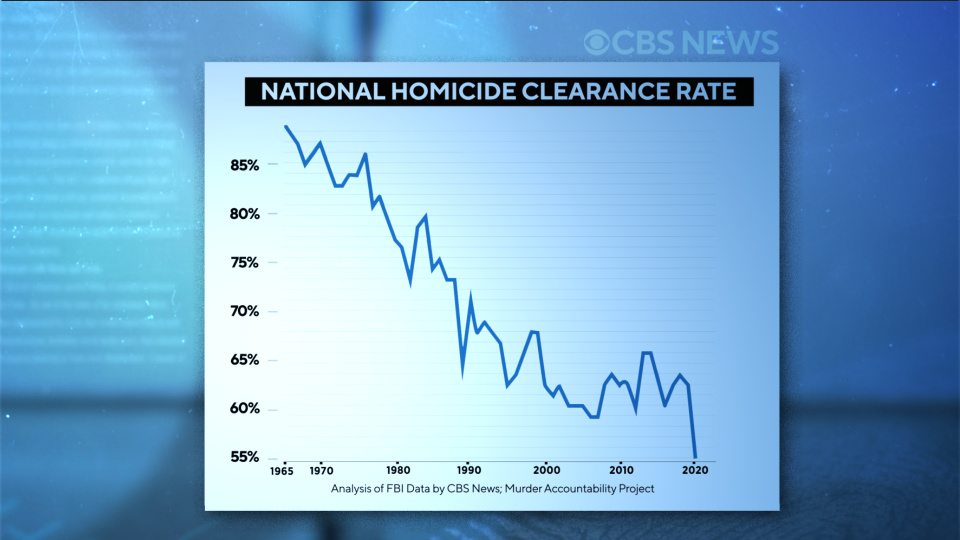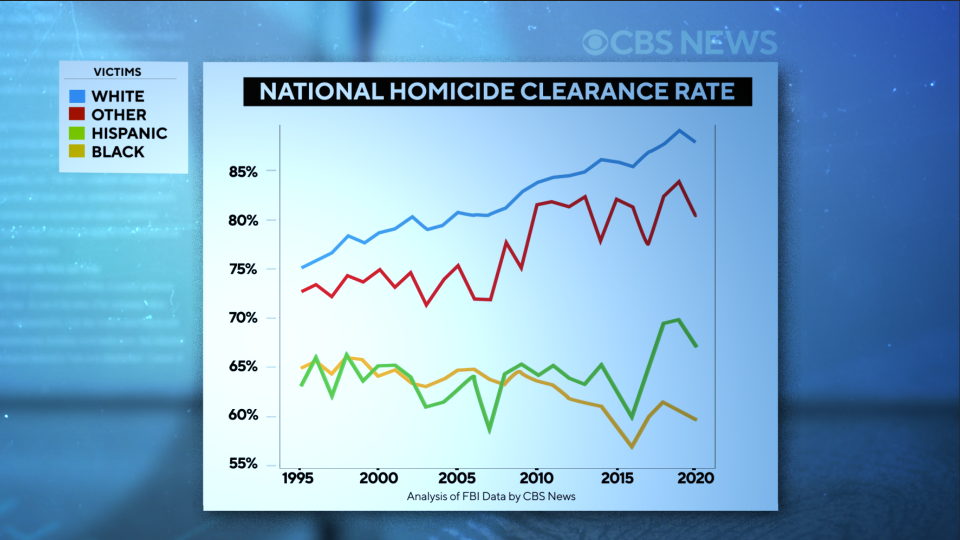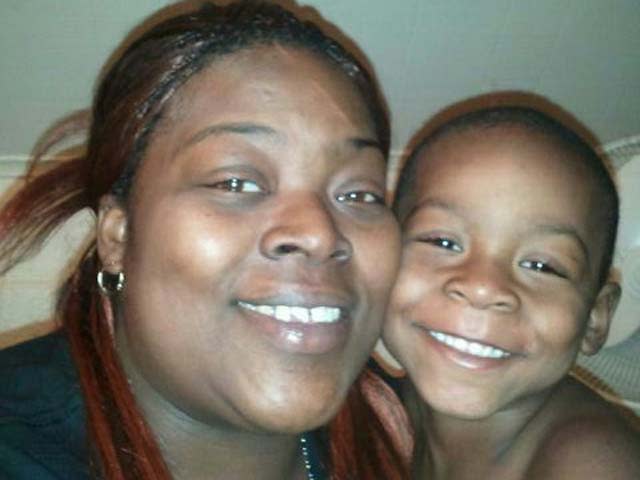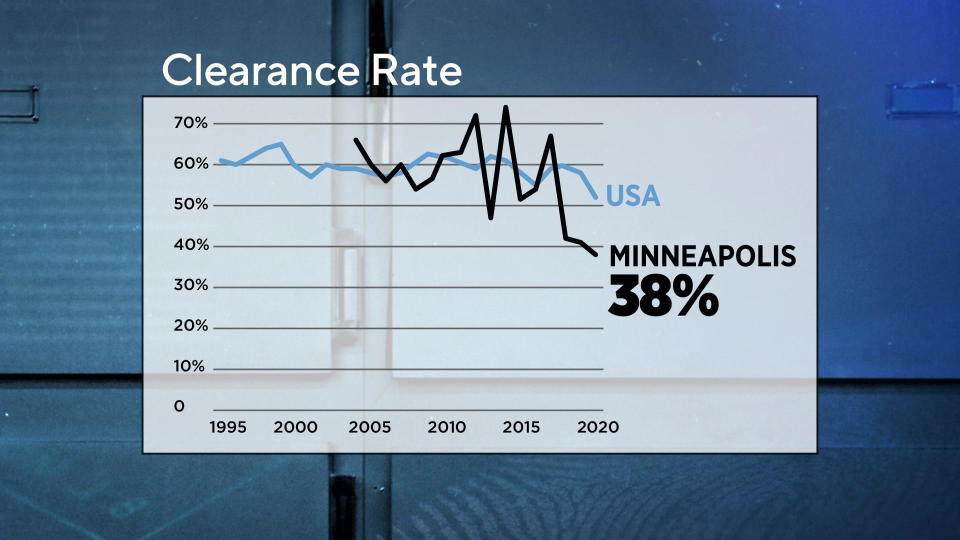U.S. unsolved homicide rates soar, and Minneapolis is pacing worse than nat'l average
MINNEAPOLIS -- In a collaboration with CBS News, WCCO examines a crime often going without punishment in our country. Barely half of murder cases in the United States get solved. The national homicide clearance rate is at an all-time low, according to FBI data.
In the mid-1960s, more than 90% of murders were solved, generally resulting in an arrest.

By 1990, the percentage fell into the sixties. Then, by 2020, as the number of homicides surged, the national clearance rate dropped to about 50% for the first time ever.

Our analysis with CBS News also discovered a difference by race. The national homicide clearance rate for White victims keeps improving. While the rate of solving murders for Black and Hispanic victims is much lower.
So we wanted to know what's happening locally. Our investigation discovered Minneapolis' clearance rate fell below historic lows in recent years and, as WCCO's Jennifer Mayerle reports, had police double-checking their own numbers.
The day after Terrell Mayes, Jr. celebrated Christmas with his family, the 3-year-old and his siblings heard gunshots. A stray bullet struck Terrell as he ran up the stairs to safety inside his north Minneapolis home. The year: 2011.
"He was only 3, he didn't get to live his life," Terrell's mom Marsha Mayes said in 2011.

For more than a decade, WCCO has followed his grieving mother's push to find her son's killer. Year after year, Mayes has stayed the course, while investigators worked leads and offered a sizeable reward.
"We need a solid witness that really knows something about this case," Minneapolis police Lt. Richard Zimmerman said in 2015.
"I miss my baby, my baby meant more to me than life," Mayes said.
Years after losing Terrell, she remembers her youngest son.
"Do you still think about who could've done this?" Mayerle asked.
"All the time," Mayes answered.
Terrell's killer has never been caught. Knowing the gunman responsible may be living free weighs on Mayes.
"In my eyes, people are suspects to me," Mayes told Mayerle.
"What is it like living that way?" Mayerle asked.
"It's hard, it's evil, it's dysfunctional," Mayes said.
Mayes feels police could be doing more.
"Do I feel as if they're doing enough? No. Do I feel they should still be knocking on doors? Yes. Somebody still knows what happened that night," Mayes said.
Homicide clearance rates in Minneapolis have taken a nose dive. The department sends data to the FBI annually. It records the number of homicides the department cleared that year. As the national average hovers at a historic low around 50%, Minneapolis plummeted below that in 2018, bottoming out at 38% in 2020.

Minneapolis Police tell us homicide investigations are complex, and clearance rates are impacted by a number of factors. MPD says it's reviewing internal data to check for accuracy after we showed them this data.
WCCO spoke with Zimmerman earlier this year. The head of homicide said unsolved cases keep him up at night.
"They all weigh on you to some degree, because there's a mother, or brother or sister or son or daughter that lost a loved one," Zimmerman said.
Zimmerman noted there is no statute of limitation on homicides. And said tips are crucial.
"I've never run into a case that's not solvable. It's just a matter of does the person that knows something about it want to help now or not?" Zimmerman said.
Zimmerman said despite officers leaving the department in droves, the number of homicide detectives has stayed at 12. And as murders have increased, MPD turned to state and federal partners for assistance. FBI, ATF and BCA agents are embedded with the homicide unit.
"That's helped immensely for the cases, and the victim's families," Zimmerman said.
MPD says according to their records, clearance rates came up in 2021. Sharing numbers yet to be published with the FBI, they say will show a 20% increase in cleared cases -- noting internal partnerships, community partners, technology, and tips all play a role.
"We actually care about the victims. We actually care about the survivors of these victims, and getting them some sense of justice," Zimmerman said.
But Marsha Mayes believes the erosion of trust with police also has an impact.
"You think if there was more community trust, they'd solve more?" Mayerle asked.
"Exactly. I got trust in some, not all," Mayes said.
While she waits for justice, she continues to speak up. She visits Terrell's memorial garden to find peace. It's a place she connects with the son who will never grow old.
"When you pass by here you should always know a 3-year-old was killed here in this area. You should always know that his family -- our Mayes -- are looking for justice," she said.
There is still a $60,000 reward for information leading to an arrest in Terrell's case.
What we found locally is part of a CBS News investigation of the reasons for unsolved murders across the country.
Complete coverage of "Crime Without Punishment" from our CBS stations across the country and CBS News is available here.
Dr. Celine Gounder on Omicron booster shot and Monkeypox concerns
R. Kelly sentenced to 30 years in prison on federal sex trafficking charges

